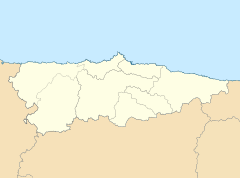 Carved staghorn found in the cave | |
| Location | Ribadesella |
|---|---|
| Region | Asturias, Spain |
| Coordinates | 43°27′38.52″N 5°4′3.72″W / 43.4607000°N 5.0677000°W |
| Official name | Tito Bustillo |
| Type | Cultural |
| Criteria | i, iii |
| Designated | 1985 (9th session) |
| Part of | Cave of Altamira and Paleolithic Cave Art of Northern Spain |
| Reference no. | 310-003 |
| Region | Europe and North America |
| Buffer zone | 243.38 ha (601.4 acres) |
| Official name | Cueva de Tito Bustillo |
| Type | Non-movable |
| Criteria | Monument |
| Designated | 12 March 1970 |
| Reference no. | RI-51-0003839 |
The Tito Bustillo Cave is a prehistoric rock shelter located in the small town of Ribadesella, in the autonomous community of Asturias, Spain. The cave was inhabited by humans (cro-magnon) before the year 10,000 BC. Due to the collapse of the rock, the original entrance to the cave was sealed thousands of years ago, which made it possible for preservation of objects, tools and wall paintings that were discovered in 1968. Based on those objects found in the cave, it is known that there was a significant human presence during the Magdalenian culture of the Upper Palaeolithic, but the cave was probably inhabited before that time.

The Tito Bustillo Cave has been designated a World Heritage Site, as part of the Cave of Altamira and Paleolithic Cave Art of Northern Spain, and it counts with 12 prehistorical paintings, making it one of the most complete examples of the prehistoric art in the north of Spain. The oldest of these paintings shows human figures and is around 33,000 years old,[1] as determined by radiocarbon dating. Some scientists believe it could have been made by Neanderthals,[2] though this theory hasn't been proven.
Some of the paintings represent animals: horses, deer, moose and even a marine animal (probably a whale) [3] and they are believed to have had some kind of ritual purpose to improve their hunting. There is also a panel representing female genitalia and it is believed to have had the intention to invoke fertility. The oldest painting in the cave represents an anthropomorphic figure, part male, part female.
Apart from the paintings, some objects from the Magdalenian period were perfectly preserved. The most important ones are some harpoons made of bone and a carved staghorn of a goat head.
YouTube Encyclopedic
-
1/5Views:11 0361 0151 3725 899311
-
Visita virtual a la Cueva de Tito Bustillo
-
El Panel Principal de la Cueva de Tito Bustillo
-
Visita virtual Los espacios ocultos de Tito Bustillo
-
Día de cuevas en Asturias
-
SALIDA CUEVA TITO BUSTILLO
Transcription
References
- ^ Polledo González, Miguel (2011). El arte Paleolítico de Tito Bustillo : cazadores y artistas en la cueva del Pozu'l Ramu (1st ed.). Pola Siero, Asturias: Ménsula. pp. 112, 114. ISBN 9788461499397. OCLC 796271309.
- ^ Jha, Alok (June 14, 2012). "Neanderthals may have been first human species to create cave paintings". The Guardian. Retrieved December 16, 2016.
- ^ "Centro de Arte Rupestre Tito Bustillo".



